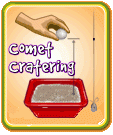
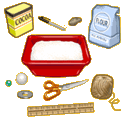
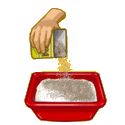
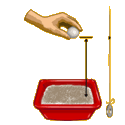
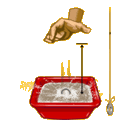
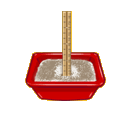
Experiment Category:
Objective:
Make impact craters and compare the size and depth of them.
What You Need:
- Flour (or sand or potting soil)
- 1 cup hot chocolate powder or cocoa (or flour if using sand for #1)
- Large, deep container
- Ruler
- Small, medium and large marbles (or rocks, ping pong or golf balls)
- 1.5 meters of string
- Washer, small rock or other weight
- Chair
- Drop cloth, newspaper or other floor covering
To Do and Observe:
1. Lay down the drop cloth or newspaper (or try this outside - its kind of messy).
2. Place the container in the middle and fill the tray three inches high with flour (or sand or soil). Make sure the flour is spread evenly across the pan.
3. Sprinkle a THIN, even layer of hot chocolate powder on top.
4. Move a chair close to the tray. Gather the impactors (marbles or rocks), string and ruler.
5. Make craters by following these steps:
a. make sure the string is 1.5 meters in length. Tie a washer on the end so it hangs straight down.
b. Mark the string at 30 cm and again at 1.5m
c. Estimate the diameter of each of your impactors using a ruler.
d. Note which impactors are heavier than the others.
e. Drop the first impactor from a height of 30 cm.
f. Measure the diameter and depth of the crater, then carefully remove the impactor. Record your findings.
g. Drop the first impactor again from a height of 1.5 m. Be sure to drop it away from your first crater (so you make a fresh one). Record your findings.
6. Repeat step #5 with your other impactors.
7. How does the height of the object - or distance from the surface - affect the impact crater?
8. How does the size and mass of the object affect the impact crater?
What's Going On:
When comets and asteroids collide with solid bodies such as planets they create impact craters. The size and depth of impact craters increase with the size, speed and/or travelling distance of the comet. Comet collisions not only change the physical structure of the impacted bodies; they may also change an entire ecosystem and cause mass extinction events.
Parent/Teacher Tips:
Before you begin, ask the children what they know about comets. Ask them how craters were formed and find pictures of impact craters on the earth or on the moon.
Add other variables such as angle (trajectory), height dropped, speed (velocity), and shape of object vs. shape of crater. Can you measure the ejecta (particles displaced from the crater)? If so, how far from the rim of the crater did the ejecta travel?
